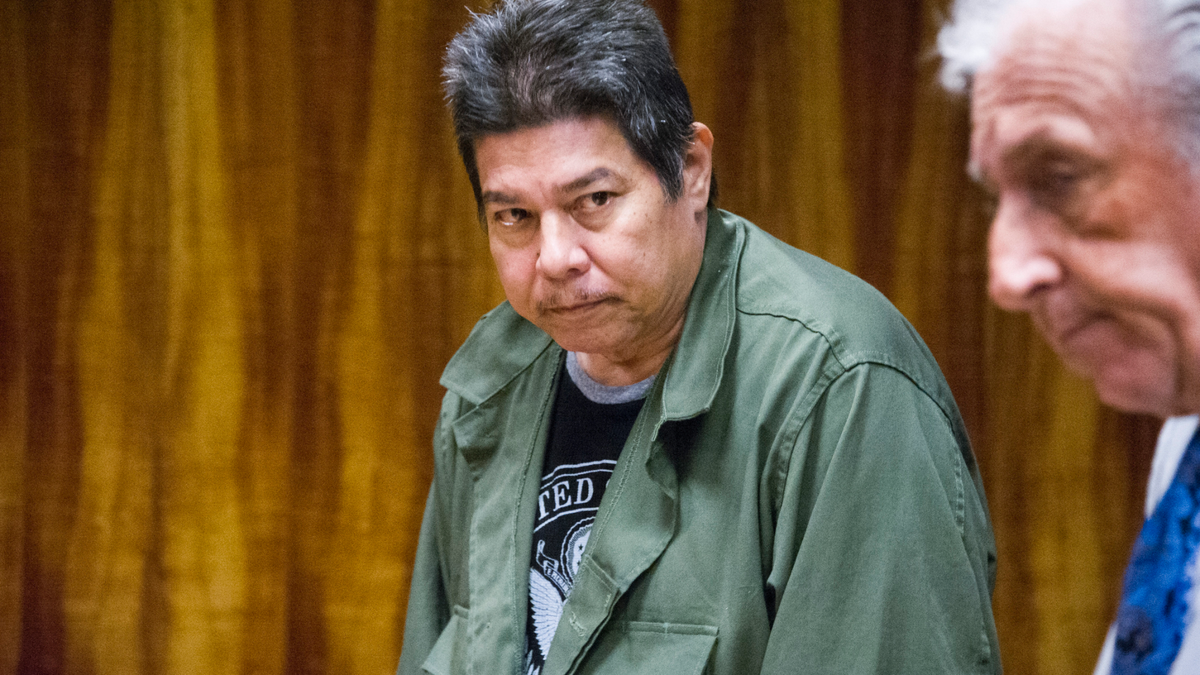
FILE - In this April 26, 2018 file photo Randall Saito appears in court for a hearing on his mental competence to stand trial in Honolulu. Hawaii officials said they are ready Wednesday, Dec. 12 to discuss findings of an investigation into Saito's escape from a psychiatric hospital. The state attorney general's office has completed an administrative investigation more than a year after Saito escaped from Hawaii State Hospital. Saito was sent to the hospital in 1981 after being found not guilty by reason of insanity of killing a woman. He was captured in Stockton, California, days after walking out of the hospital last November. (Craig T. Kojima/Honolulu Star-Advertiser via AP, Pool,File)
HONOLULU – No single employee was directly responsible for the escape of a man from a Hawaii psychiatric hospital, a state investigation found, but questions remain about how he was able to walk out of the facility and fly to California, officials said Wednesday.
The state attorney general's office completed an administrative investigation more than a year after Randall Saito escaped from Hawaii State Hospital. Officials on Wednesday released findings of the investigation, but they said a redacted report will be posted online later Wednesday or Thursday.
The investigation found that the hospital's inability to adjust to patients sent there through the criminal courts system was partly to blame.
Staff members were complacent about Saito's escape risk, state Health Director Bruce Anderson said.
Saito was sent to the hospital in 1981 after being found not guilty by reason of insanity for killing a woman in 1979 in a shopping mall.
"If there was any problem at the state hospital it was one of complacency with regard to Randall Saito in particular," Anderson said. "He was there for 30 years. People got used to the idea of him being there."
He caused no problems before he escaped in November 2017, Anderson said: "He spent 37 years there without incident." Saito was a model patient, Suzuki said.
In 1993, a court denied Saito's request for conditional release, saying he still suffered from sexual sadism and necrophilia.
Psychiatrists who evaluated him over the years also said he could be personable, charming and had good social skills.
Dr. Gene Altman, who evaluated Saito in 2010, said he had six significant relationships since being committed. Three of those were reportedly with hospital staff members and the others were with women in the community, including Saito's first and second wives, according to Altman's assessment, filed in court records.
Saito was the impetus for a rule change in 2003, when the state attorney general's office decided mental patients committed to the state hospital have no legal right to conjugal visits.
The issue came to light when the hospital administrator learned Saito had been escorted home for weekend conjugal visits over two years. The administrator blocked the visits away from the facility and on its grounds.
After Saito's escape, six hospital employees were placed on off-duty status. Two have since retired, and the other four will be reinstated to their positions.
No hospital employees will be disciplined.
Saito was captured in Stockton, California, days after walking out of the hospital.
After leaving the hospital, Saito called a taxi that took him to the airport, where he took a chartered flight to Maui. He used an alias to arrange the flight and paid $1,445 cash for it, prosecutors said. Then he took a commercial flight to San Jose, California, prosecutors said.
When he was arrested three days after his escape, he had more than $6,000 in cash and fake Washington state and Illinois driver's licenses bearing his photos with different names, prosecutors said. The fake licenses contained convincing-looking holograms that are difficult to reproduce.
No employee provided Saito with materials that helped him escape, including a cellphone, cash and fake IDs, state Attorney General Russell Suzuki said. "If anything it would have been an outsider," he said.
Anderson said Saito's escape was a "wake-up call" that prompted changes at the hospital including a fence around the facility and logs that better track patients' whereabouts.
There have been no escapes since, he said.
"We realize there's still many questions regarding Saito's escape," Anderson said.
Hospital surveillance footage shows Saito taping door locks for a lounge and retrieving a garbage bag from a combination-locked cabinet on the morning of his escape, according to a detective's affidavit.
He took clothes out of the bag and changed. He threw the bag with his old clothes in a trash bin and then opened a combination lock to get out of the hospital, the affidavit said. It's not known how he knew the combination.
Suzuki said he doesn't have information about the combination and would look into it.
In the taxi, Saito had a backpack that he didn't have when he left the hospital grounds.
It took the hospital at least eight hours to notify law enforcement that Saito was missing.
While jailed in California after his capture, Saito gave various interviews with reporters, including The Associated Press. He said he escaped to show that he should be free.
Saito remains incarcerated in a Honolulu jail. He pleaded not guilty to escape and identity theft charges.
His attorney, Michael Green, has said his family doesn't plan to post $500,000 bail. Saito prefers Oahu Community Correctional Center to the state hospital, Green said. A court hearing is scheduled for Thursday.
__
This version corrects that Hawaii Health Director Bruce Anderson said Saito caused problems before his escape. Anderson said Saito caused no problems before the escape.

